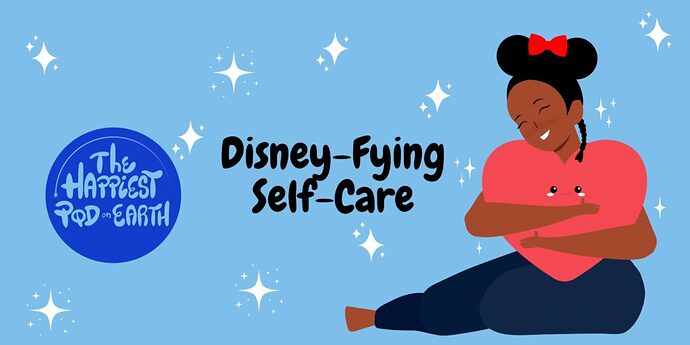Originally published at: Using Disney to Understand and Incorporate Self-Care - The Happiest Pod on Earth
Self-care. This buzz word that we hear about, but we aren’t really sure what it means. Our jobs may give us career-building workshops, where self-care is in the foreground of the conversation. Or we may hear it from our therapists or the media. But it is never clearly defined. We have a vague idea of its importance but aren’t sure exactly what it is. Often, it becomes synonymous in our minds with being self-indulgent or being selfish. In the 11th episode of The Happiest Pod on Earth, here on the GT Network, Stef and I focus on “Disney-Fying Self-Care.” We dive into tips and tricks, for both professional and personal use, on the different ways we use Disney mediums to incorporate self-care into our everyday lives.
We of course start by defining self-care. We describe it as a conscious act. We believe it is the active engagement and participation in a practice that is meant to establish and maintain specific pillars of wellbeing. When it is actively engaged in, it prevents illness or deterioration. The pillars we lean on are hygiene, lifestyle, nutrition, environment, medical care, mental care, and cultural connection.
The seven pillars of self-care as described by The Happiest Pod On Earth:
- Hygiene: conditions and practices that help sustain health and prevent the spread/contagion of diseases. These practices may include living and working conditions that are sanitized, washing hands, regulated sleep schedules, brushing teeth, etc.
- Lifestyle: the habits, moral standards, attitudes, world view, and economic level that support an individual’s underlying needs. These habits may include travel, attending church, having a collection (such as Funko Pop figures or coins), volunteering, painting, investing, etc.
- Nutrition: the act of a balanced intake that meets the needs of physical, mental, emotional, and spiritual needs. These acts may involve eating a balanced diet, communicating assertively, learning new skill-sets, cooking, prayer, meaningful conversation, etc.
- Environment: having a cultivated space that inspires and promotes well-being, a sense of belonging, and a sense of purpose. These spaces could include a gym, supportive school setting, supportive work setting, creating a comfort corner, playing comforting music, having a decluttered household, room in a relationship to express feelings, affirming friendships, access to childcare, etc.
- Medical Care: the ability to practice and process health information, obtain resources for medical care, and access to medical-based treatment. This could mean both having and using insurance, having a primary care doctor, attending regular check-ups, taking time to heal when sick, engaging in medical needs appropriately (such as taking medication at the prescribed amounts), freedom to discuss medical concerns, having medical conditions fully explained, attending physical therapy, attending acupuncture, etc.
- Mental Care: the ability to practice and process health information, obtain resources for mental care, and access to mental health-based treatment. This could mean both having and using insurance, having a therapist, attending a support group, engaging in mindfulness-based practices, talking to a school counselor, engaging in mental health needs appropriately (such as taking medication at the prescribed amounts), freedom to discuss mental health concerns, supportive relationships, boundaries around mental and emotional labor, etc.
- Cultural Connection: acts that create belonging, attachment, and understanding of the various intersecting parts of an individual and the cultures they define themselves in. These acts may be celebrating holiday gatherings, running programs at local festivals, attending church, teaching traditions to younger family members, visiting family of origin, visiting country of origin, eating culturally impactful foods, wearing culturally significant clothing, ancestry veneration, etc.
There are a variety of tips for self-care practices that we provide for listeners. One that we highlight as crucial includes both learning and engaging in the practice of mindfulness. Mindfulness and meditation have been utilized by numerous religions and secular traditions, such as Buddhism, Hinduism, Judaism, and Islam. There are even areas of Christianity that utilize meditative prayer as part of the spiritual and religious engagement. Mindfulness is the practice of being fully present and fully aware of the current moment. This awareness also includes responding to the current moment without judgment or reactivity. Studies have shown regular mindfulness-based practice provides people with a variety of benefits. These include, but are not limited to, decreasing stress, improving academic success, and preventing burnout. Due to mindfulness being an active practice of sustained focus and attention, we find that it is connected to the self-care pillars of mental health, environment, and even lifestyle.
Of course, we kept Disney mediums in mind when providing a specific mindfulness-based practice to include as part of regular self-care. Stef and I identified the use of Disney+’s shorts, Zenimation, to engage in mindful moments. This series of shorts focuses on refreshing the senses using Disney animation and sound for a mindful moment. Each episode, except for the final one, is about seven minutes long and centers around a specific theme. The themes vary from the environment based, like “Ocean,” to feeling states, such as “Discovery.” Each episode takes these themes and combines clips and soothing sounds from Disney movies which would match the theme. The podcast continues on with other Disney-fied self-care suggestions, including practices that involved Disneyland parks or connections with family and friends.
Listen to the full podcast episode here: Disney-fying Your Self-Care.
